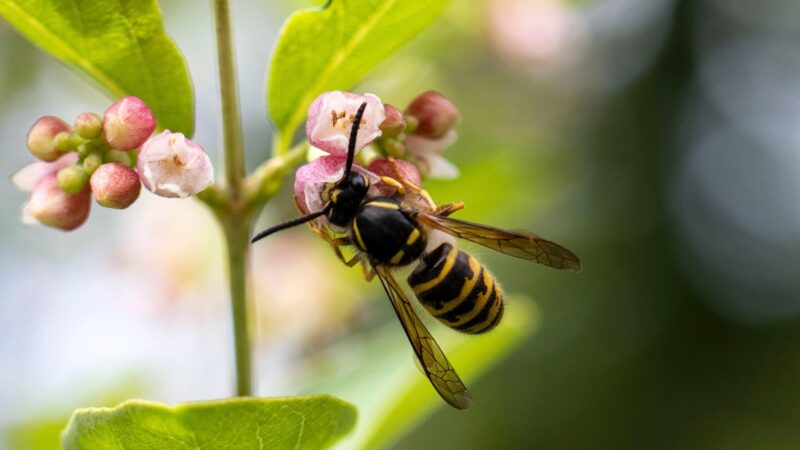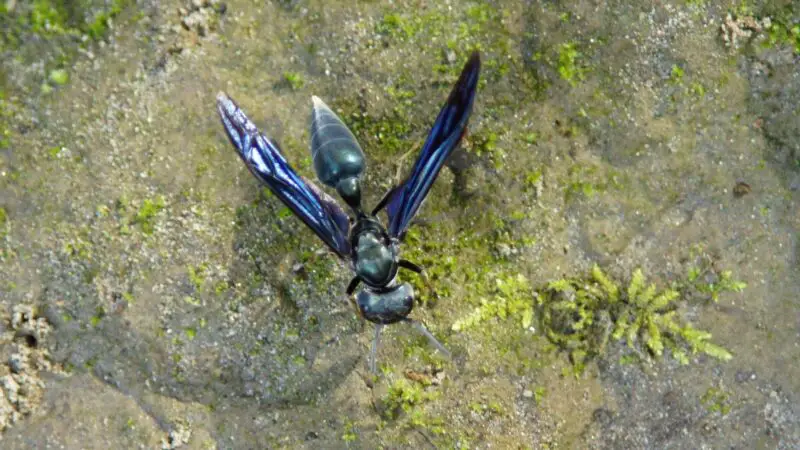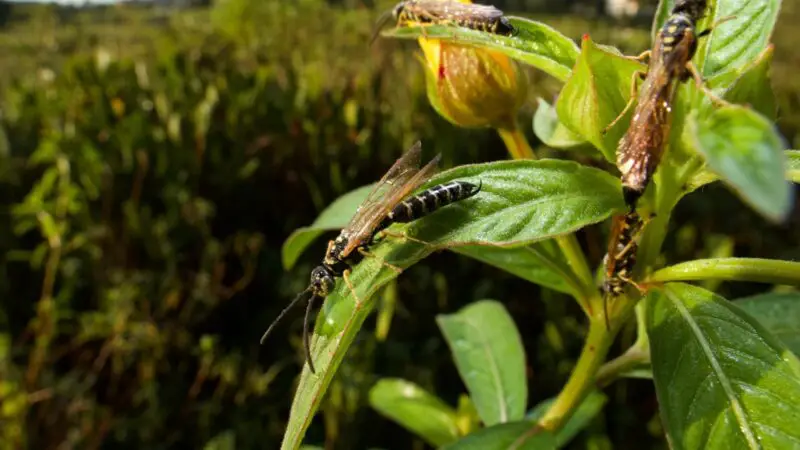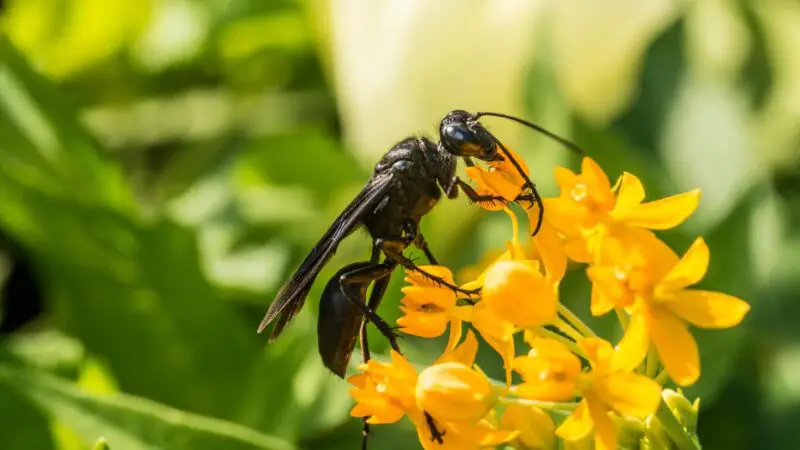Wasps are notoriously known for being extremely territorial and stinging when disturbed or threatened. However, they actually serve important ecosystem functions. You would be surprised that they share similar roles to bees!
Certain types of wasps pollinate flowers, figs, and other nectar and/or pollen-producing plants, including goldenrods and orchids. These are the fig wasps, pollen wasps, spider wasps, thynnine wasps, spider wasps, paper wasps, and other species such as great black wasps and yellowjackets.
This article will provide you with everything you need to know about the pollinating prowess of wasps, what types of wasps are able pollinators, what species of flowers and plants they pollinate, the ecological roles of wasps outside of pollination, and other interesting information. So sit tight and read further!
Are Wasps Good for Anything?
Wasps are actually beneficial. They prey on other garden pests including flies, crickets, and a variety of caterpillars such as armyworms, corn earworms, and hornworms that are usually found on shrubs and flowers. In fact, wasp colonies are known to consume an average of 2.12 pounds of insects per hectare they cover.
Some wasps also help control invasive insect species, like parasitoid wasps, which inhabit the bodies of their prey and lay eggs inside of them. They are currently being used to control and slow down the spread of Emerald ash borers, a jewel beetle that feeds exclusively on ash trees.
Also considered as saprophagous insects or insects that feed on the dead bodies of plants and animals, wasps belong to the saprophagous group that feeds on carrion. As a result, they help in the decomposition of dead plants and animals as well as the recycling of nutrients.
Furthermore, European hornets and paper wasps have also been shown to carry yeasts to grapes used for winemaking. This indicates that they are important helpers of the fermentation process of wine.
Do Wasps Pollinate Your Garden?
Wasps do pollinate your garden. They are able pollen vectors that visit flowers for both nectar and insect prey. Pollinating wasps will collect pollen and cache it in their crops internally instead of on their exterior bodies like how bees do.
Wasps are efficient pollinators of plants that self-pollinate. However, they are not helpful for those that cross-pollinate or plants that fertilize the ovules of another plant by way of pollen transfer.
Since they lack enough hair structures on their bodies, they are less efficient at carrying pollen compared to other known pollinators such as bees and butterflies, whom they encounter often during pollination. However, in some plant systems, such as for the Brazilian Peppertree (Schinus terebinthifolius), wasps are even found to be more abundant pollinators than bees.
What Flowers Do Wasps Pollinate?
Wasps are attracted to generalist flowers with dull coloration, are readily accessible, have aromatic odors, and have nectar that are concentrated. These include flowers in the parsley family, orchids, pineapple lilies, notch-leaved phacelia, goldenrods, tansies, beardtongues, borages, and brazilian peppertrees.
Do Wasps Pollinate Vegetables?
Wasps also consume the nectar of self-pollinating vegetables such as lima beans, tomatoes, and peppers.
Do Wasps Pollinate Fruit Trees?
Wasps pollinate fig plant species which are considered trees that bear fruits with flowers that bloom inside the immature fruit. They also pollinate other varieties of self-pollinating fruit trees such as peaches and apricots.
What Kind of Wasps Pollinate?
Fig Wasps
Fig plants and fig wasps have developed an obligate mutualism wherein all figs are being pollinated by fig wasps that exclusively feed on figs. According to this study, this is an extreme example of pollination specialization in plants and a co-divergence in fig-wasp relationships.
Pollinating fig wasps belong to the subfamilies Agaoninae, Kradibiinae, and Tetrapusiinae. They include the Pegoscapus mexicanus which pollinates the strangler fig (Ficus aurea) and the Pegoscapus tonduzi which pollinates the shortleaf fig (Ficus citrifolia).
Common fig wasps include those belonging in the genus Blastophaga, such as the Blastophaga psenes which is known to pollinate the common fig (Ficus carica) and the Punjab fig (Ficus palmata).
Pollen Wasps

Pollen wasps belong to the Masarinae subfamily. They are considered peculiar species as they exhibit bee-like behavior such as utilizing pollen and nectar to construct nests and providing their larvae food. Due to this, they are also referred to as vegetarian wasps since they feed on and use nectar and pollen almost exclusively rather than preying on insects.
They are important pollinators that specialize on very specific flower species such as tansies (Tanacetum vulgare), beardtongues (Penstemon), and borages (Borago officinalis). They have longer mouthparts compared to other wasp species. This allows them to seep nectar from within flowers with deep and narrow corolla tubes.
Spider Wasps

Adult spider wasps are also more commonly found on flowers. Although they primarily feed and control spider and aphid populations, they are also pollinators of certain native plant species such as Disa sankeyi and the African Milkweed (Pachycarpus asperifolius).
Thynnine Wasps

Adult thynnine wasps, also called flower wasps, feed on nectar and are considered minor pollinators. Species like the blue ant (Diamma bicolor) and wasps belonging to the subfamily Anthoboscinae pollinate native Australian flowers such as crinkle bushes (Lomatia silaifolia) and hoary sunrays (Leucochrysum albicans).
However, it is important to note that not all thynnine wasps are capable of pollinating such as those belonging in the Methochinae subfamily.
Paper Wasps

These wasps are members of the Polistinae subfamily. They are also considered pollinators that feed on nectar of flower species such as goldenrods (Solidago).
Other Species

Great black wasps, a species of digger wasps, pollinate a variety of perennials, including the rattlesnake master (Eryngium yuccifolium). They are commonly found consuming pollen and nectar during the summer season.
Yellowjackets are also considerable pollinators and often scavenge through flowers and plants for nectar. They often pose a problem for bees, however, when nectar sources are drastically reduced in a certain area as yellowjackets predate on adult bees when nectar is scarce.
Are All Fig Trees Pollinated by Wasps?
Not all fig trees are pollinated by wasps. However, nearly all fig trees are pollinated exclusively by wasps of the Agaonidae family. There are over 750 species of figs in the world and each requires its own species of wasp.
However, commercially-grown figs can be grown without pollination, or in other words, do not require pollination by fig wasps. Instead, gardeners trick them to ripen by spraying them with plant hormones. Common figs also do not need pollination and are usually grown in home gardens.
How Do Wasps Pollinate Figs?
Fig wasps perform a complex pollen transfer system. This allows seeds in a fig fruit to develop while also providing a place for wasp offspring to grow in.
Here is how fig wasps pollinate figs:
Step 1: Each fig in a plant is formed by tiny flowers that face towards the inside of the fig. When the female flowers are ready to be pollinated, the fig will exude an aroma that attracts female fig wasps that specifically pollinate that fig plant species.
Step 2: Once the wasp locates the fig, it will push itself into the small and tight passage of the fig, losing its wings and parts of its antennae in the process.
Step 3: The wasp moves around the immature fruit and visits many flowers in the process. Once it has settled itself, it will lay eggs inside the unborn seeds that will help nourish its offspring. While doing so, the wasp also spreads pollen it has collected from the fig plant it was born in.
Step 4: After the wasp lays its eggs, it dies inside the fig. The newborns will hatch and mate among themselves. The males will chew an exit out of the fig for the females and then die after fulfilling their intended roles.
Step 5: The newly-born female, on the other hand, will collect the pollen inside the fig plant then exit through the tunnel built for them, search for new fig trees, and repeat the cycle.
Do Wasps Pollinate More Than Bees?
Wasps don’t pollinate more than bees, as most wasps are carnivores and feed primarily on other insects. Despite being able to consume nectar and pollinate plants in the process of doing so, they are still less efficient pollinators compared to bees, whose primary ecological role is to collect and consume pollen and nectar as well as convert them to honey.
How Long Does It Take Wasps to Pollinate?
It is unknown how long wasps take to pollinate flowers, figs, and other nectar- and/or pollen-producing plants. They usually take foraging trips that are within a few hundred meters to a kilometer away from their nest entrance.
Who Pollinates Plants?
Bees are excellent pollinators as they collect nectar and pollen to create honey, provide to larvae, and build colonies. They are not picky when it comes to foraging and, depending on the quality of their foraging areas, they will make around 10 to 15 foraging trips daily and visit about 100 flowers per trip.
Beetles are often referred to as “mess and soil” pollinators. This is because they fumble their way through plants to look for food, potential mates, and even to defecate. They usually visit flowers that are close to the ground as well as magnolias.
Butterflies will often visit and pollinate round flowers with petals that are flared and have narrow throats, such as sunflowers and salvias. They have long tongues, called proboscis, which help them probe into the flower’s nectary glands.
Flies are specifically attracted to flowers that have bad odors or fur-like textures and consume their nectar, such as pawpaws, viburnums, and Dutchman’s pipe.
Hummingbirds have long, thin beaks and specialized tongues. This allows them to probe for nectar concealed deep within tubular flowers such as honeysuckles and beebalms.
Moths are mostly unnoticed pollinators as they are more active at night and are dull in color and appearance. They visit night-blooming flowers with aromatic scents such as moonflowers and four o’clocks.
Other Wasp Benefits
Aside from pollination, wasps are great for pest control, especially for flies, crickets, katydids, grasshoppers, and a variety of caterpillars. They also feed on carrion as well as on the insects that feed on carrion. This helps in decomposition and the recycling of nutrients.
Moreover, paper wasps and European hornets are able to attach yeasts onto themselves. Then, carry them over to winemaking grapes, aiding in the fermentation process.
Despite being notorious stingers, wasps are able to pollinate self-pollinating, generalist flowers, vegetables, and fruit trees (primarily figs). However, they are not as efficient as bees as most species feed on insects instead of pollen and nectar. Aside from this, they also perform other important ecological roles. It includes pest control, aiding in decomposition and nutrient recycling, and carrying yeast for winemaking.
List of Sources
Protecting Honey Bees from Yellowjacket Wasps
Beneficials in the Garden: Paper Wasps
